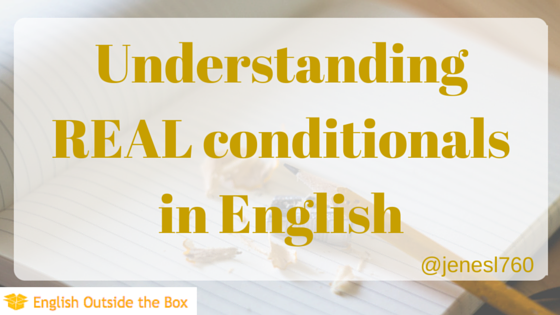
Understand REAL conditionals in English
(EXAMPLE 1)This post is helpful if you want to improve your English. If you are reading this post, you are probably studying English. If you are not studying English, you are a fellow teacher or just an English lover.
(EXAMPLE 2) If you continue reading this post, you will better understand the real conditionals in English. You will speak and understand English more effectively if you better understand these conditional tenses.
Hopefully you are not feeling confused; however, I wanted to introduce the grammar point to you with examples before we get into today’s lesson. Before I explain the use, structure, and meaning of the real conditional tenses I want you to first look at the examples above. Analyze the sentences for a minute and think about these questions. If you can, try and answer them in your notebook!
- Which example is for the present real conditional?
- Which example is for the future real conditional?
- What do you notice about the use of the comma ( , ) Specifically, when do we use the comma with conditional sentences?
- Which time tenses (present, past, future — continuous or simple) do you see being used in the above example sentences?
I will answer these questions a little later in the post, but let’s review some of the grammar details first.
What are real conditionals in English?
The real conditionals are also known as the zero conditional (conditional O) and the first conditional (conditional I). These conditional statements represent real results/actions happening if a particular condition is met. These situations are real because they are true statements, facts, or very likely outcomes.
When do we use real conditionals in English?
We use the real conditionals when we talk about things that are real and/or extremely likely to happen.
We can use conditional 0 (zero conditional) to talk about facts, statements, truths, and what we normally do in real-life situations. This is called the present real conditional, so it’s used when we talk about things in the present time, now.
The future real conditional, conditional I (1st conditional) describes what you think you will do in a specific situation in the future. Although we can never be 100% certain about future events, this is still called the “real” conditional because it is very likely to happen and probably will happen in the future. It’s used to make guesses and statements about future events.
What is the grammatical structure of the real conditionals in English?
The simple present or the present continuous is used in the IF clause in BOTH the conditional 0 and conditional I. The simple present or present continuous is used in the result clause of conditional 0, and will + base verb is used in the result clause of conditional 0. If you are visual, here are examples:
CONDITIONAL 0:
IF CLAUSE ( If + subject + simple present/present continuous…), RESULT CLAUSE (subject + simple present/present continuous …)
If water is 32 degrees (F), it freezes.
If I am eating soup, I use a spoon.
If LuLu Bear (my cat) is running outside, she is chasing a lizard.
In this conditional tense, the zero conditional, you can also replace IF with WHEN because we are talking about things that often happen, or stating facts. So all of the examples above can be written like this:
When water is 32 degrees (F), it freezes.
When I am eating soup, I use a spoon.
When LuLu Bear (my cat) is running outside, she is chasing a lizard.
CONDITIONAL I
IF CLAUSE ( If + subject + simple present/present continuous…), RESULT CLAUSE (subject will + base verb …)
If I go outside today in the rain without an umbrella, I will get wet.
If I am not teaching this afternoon, I will go to the beach.
*IMPORTANT NOTE FOR BOTH CONDITIONALS* You only need to use a comma if the IF clause comes before the RESULT clause. You do not need a comma if the result clause comes first.
EX: Water freezes if it is 32 degrees. I use a spoon when I am eating soup.
EX: I will get wet if I go outside in the rain without an umbrella. I will go to the beach if I am not teaching this afternoon
ANSWERS TO THE QUESTIONS IN THE BEGINNING OF THE POST
Review of the information above
- The first examples are of the present real conditional (0 conditional)
- The second examples are of the future real conditional (1st conditional)
- You need to use a comma when the “IF clause” comes first, before the result clause. However, you do not need to use a comma when the result clause comes first.
- Only the simple present or the present continuous is used in the “IF clause” for both the 0 and 1st conditional. However, the result clause will vary. In the 0 conditional, only use the simple present or present continuous; however, in the 1st conditional, you need to use will + base verb
#REALenglish Examples of REAL Conditionals in English
Are you following me on Instagram yet? I post daily (sometimes 2 or 3 posts)! Ever post is a mini lesson, helping you learn real English. My definition of real English is everyday English, English that you can use in your daily life. I show you how I use vocabulary, grammar, and give you a glimpse (*a small look*) into English through a native speaker’s eyes. That’s me! I started posting this week about conditionals because it was one of the most asked for grammar topics!
Check out this post about the 0 conditional:
Check out this post about the 1st conditional:
Now it’s your turn to try your own examples. How many can you make in the comment section below? Pay special attention to the structures, remember to only use the simple present or present continuous in the 0 conditional, and that “will” is only used in the result clause of the 1st conditional. Are your commas in the right place? Double check that you have a comma if your IF CLAUSE is first. I will provide feedback below if I see any mistakes. Practice makes perfect!
Good luck and …
Happy Studying! ♥
Please take a minute to share this post using the buttons below, it’s fast easy…and I thank you tremendously for it!

 ?of commas in the above examples. When the if clause comes first, you need to use a comma in between the if clause and the result clause. The final note is that with the zero conditional, you can replace "if" with "when". So in my example I would say, "when I drive at night, I use my headlights. " To practice, try your own examples in the comment section! Good luck! #learnenglish #learn #grammar #englishgrammar #conditional #ingles #professoradeingles #gramática #dicasdeingles #englishtips #englishteacher #englishoutsidethebox
?of commas in the above examples. When the if clause comes first, you need to use a comma in between the if clause and the result clause. The final note is that with the zero conditional, you can replace "if" with "when". So in my example I would say, "when I drive at night, I use my headlights. " To practice, try your own examples in the comment section! Good luck! #learnenglish #learn #grammar #englishgrammar #conditional #ingles #professoradeingles #gramática #dicasdeingles #englishtips #englishteacher #englishoutsidethebox